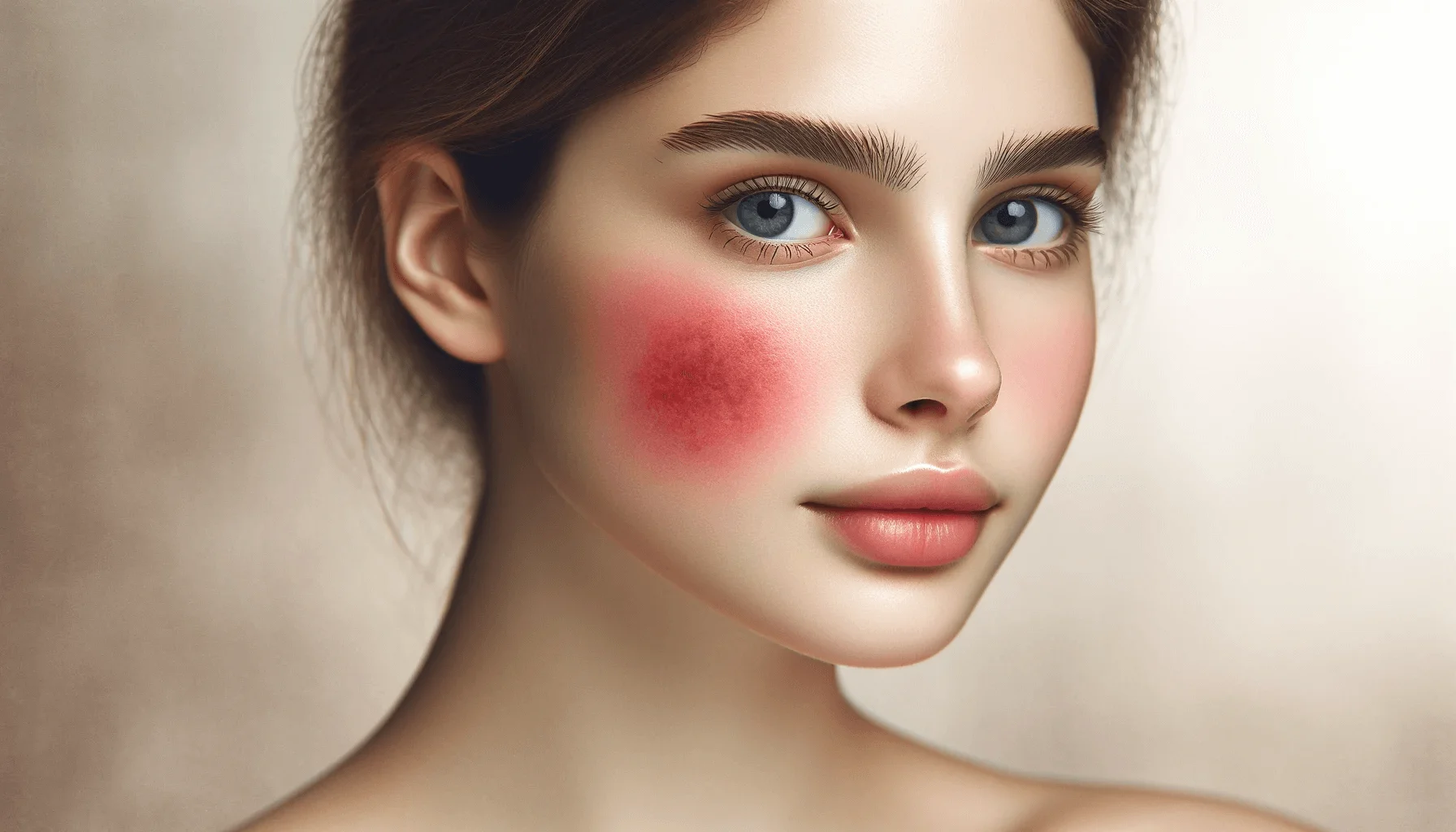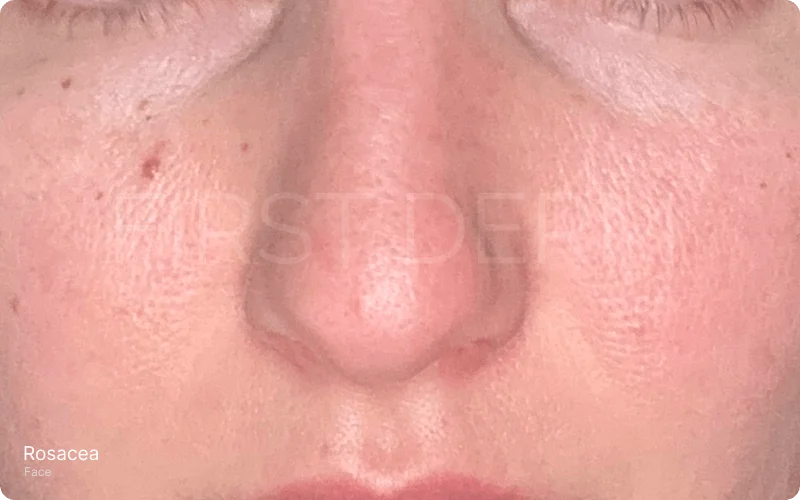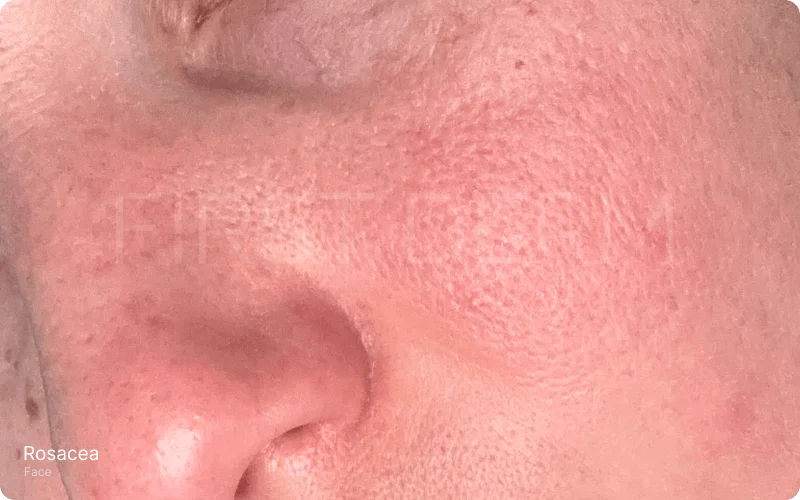Dry, Stripped-Feeling Red Skin with Visible Cheek Vessels in Winter: Sign of Rosacea?

Key Takeaways
- Rosacea is a chronic skin condition causing facial redness and bumps.
- Winter weather can worsen rosacea symptoms.
- Avoid triggers like extreme temperatures and stress.
- Gentle skincare and sun protection are essential.
- Seek professional medical advice for treatment.
Following is a user question sent to First Derm related to dry stripped, red skin.
Medical Question
Weather-induced redness started last winter. Extremely DRY, sensitive, and stripped-feeling red skin, despite using rich lotion and being meticulous about my skin care. During a flare, countless bumps and 10-20 tiny whiteheads that don’t scar, tight skin/loss of elasticity, skin feels reptilian and very rough. My pores are enlarged and I have a ton of fine lines/stretch marks.
I also have visible broken vessels around nostril bases and a couple on my cheeks. I’m very careful about wearing a ski mask outside in winter/wind, but I’m active and cat stay inside for 5 months at a time.

Rosacea is a chronic and progressive skin condition that affects millions of people worldwide. It is characterized by redness, flushing, visible blood vessels on the face, particularly on the cheeks, nose, forehead, and chin and acne-like facial papules or pustules.[1] While the exact cause of rosacea is unknown, it is believed to be a combination of genetic and environmental factors.
In winter, the cold and dry air can exacerbate the symptoms of rosacea, leading to a dry, stripped-feeling red skin with visible cheek vessels. This can be a sign of rosacea, but it is important to consult a dermatologist for an accurate diagnosis and treatment plan. Let’s explore the common symptoms of rosacea, its causes, and the available treatment options to manage this condition.
Understanding Rosacea
Rosacea is a chronic but treatable skin condition that primarily affects the central face, and is often characterized by flare-ups and remissions. It typically begins any time after age 30 as flushing or redness on the cheeks, nose, chin or forehead that may come and go. Over time, the redness tends to become ruddier and more persistent, and visible blood vessels may appear. Left untreated, inflammatory bumps and pimples often develop, and in severe cases, particularly in men, the nose may grow swollen and bumpy from excess tissue. In as many as 50 percent of patients, the eyes are also affected, feeling irritated and appearing watery or bloodshot.
Although rosacea can affect all segments of the population and all skin types, individuals with fair skin who tend to flush or blush easily are believed to be at greatest risk. The disorder is more frequently diagnosed in women, but tends to be more severe in men. There is also evidence that rosacea may tend to run in families, and may be especially prevalent in people of northern or eastern European descent.[2]
Although there is no cure, knowledge of its signs and symptoms has advanced to where they can be effectively controlled with medical therapy and lifestyle changes. Individuals who suspect they may have rosacea are urged to see a dermatologist or other qualified physician for diagnosis and appropriate treatment before the disorder becomes increasingly severe and intrusive on daily life.
How Winter Can Exacerbate Rosacea Symptoms
Winter weather can worsen rosacea symptoms due to several factors.[3]
- Cold and dry air: The cold temperatures and dry air in winter can irritate the skin and exacerbate rosacea symptoms
- Wind: Wind is a significant trigger for rosacea, and cold winter wind can be especially harsh on the skin
- Indoor heating: High indoor heat can aggravate rosacea, as it can increase blood flow and trigger facial flushing
- Decreased humidity: Low temperatures and decreased humidity can lead to skin dryness, which can further irritate rosacea
- Holiday stress: Holiday stress is a common factor that can trigger rosacea flare-ups during the winter months
Common Triggers and Risk Factors for Rosacea
Several factors can trigger rosacea flare-ups, including.[4]
- Sun exposure: Sun exposure is a major trigger for rosacea, and people with rosacea should wear sunscreen with SPF 30 or higher
- Wind: As mentioned, wind is a significant trigger for rosacea, and it is essential to protect the face from harsh winds
- Temperature extremes: Both extremely cold and extremely hot temperatures can aggravate rosacea symptoms
- Lifestyle factors: Food, emotions, and clothing can also trigger rosacea flare-ups
By understanding these triggers and risk factors, individuals with rosacea can take appropriate measures to manage their symptoms and maintain healthy skin during the winter months.
Weather-Induced Redness and Dryness: A Possible Case of Rosacea
A personal account of an individual experiencing symptoms such as, dry, sensitive, and stripped-feeling red skin which started during the winter, despite using rich lotions and being meticulous about their skincare routine. The person experiences numerous bumps and tiny whiteheads that do not scar, tight skin, loss of elasticity, enlarged pores, fine lines, and visible broken vessels around the nostril bases and on the cheeks are indicative of rosacea. The use of hydrocortisone and similar topical steroids can worsen the condition.
Importance of Professional Consultation
Consulting a dermatologist is important for a comprehensive evaluation and personalized treatment plan. Rosacea commonly appears after the age of 30 and can be exacerbated by various factors such as sun exposure, temperature changes, and certain foods. Topical and oral medications, as well as lifestyle adjustments, can help control the condition. If over-the-counter options are not effective, a dermatologist can provide prescription treatments and closer monitoring of the condition.
The importance of consulting a dermatologist is underscored by the need for an accurate diagnosis and individualized treatment plan. Additionally, the patient’s reluctance or inability to use certain medications, such as isotretinoin, highlights the need for an integrative approach, which can be effectively guided by a dermatologist.
It is crucial for individuals experiencing similar symptoms to seek professional advice and not self-diagnose or self-medicate. A dermatologist can provide the expertise and support needed to address the unique challenges posed by rosacea, particularly in the context of weather-induced redness and dryness.
Practical Tips for Managing Rosacea, Especially in Winter
Rosacea management demands a careful approach, particularly in the winter months when sensitive skin faces additional challenges. Begin by adopting a gentle cleansing routine, favoring mild, fragrance-free cleansers, and lukewarm water to prevent exacerbation of symptoms.[5]
Hydration becomes paramount in winter to combat dryness-choose non-comedogenic, hypoallergenic moisturizers. Shielding your skin from the sun’s rays with a broad-spectrum SPF 30 or higher sunscreen and regulating indoor temperatures help mitigate potential triggers. Be mindful of temperature extremes, opting for a humidifier in heated environments to maintain skin moisture. Additionally, limiting exfoliation to non-abrasive products once or twice a week prevents unnecessary irritation.[6]
Skincare Routine Recommendations for Rosacea-Prone Skin
Simplify your regimen, opting for products with fewer ingredients, avoiding alcohol and fragrances. Choose hypoallergenic products designed for sensitive skin and conduct patch tests before introducing new items. Seeking the guidance of a dermatologist for prescription topical treatments can further refine your routine. Incorporate products with soothing ingredients like chamomile and aloe vera, focusing on anti-inflammatory properties to alleviate redness. Gradual introduction of new products ensures a careful monitoring of your skin’s response.[7]
Lifestyle Adjustments to Minimize Flare-Ups
Beyond skincare, lifestyle adjustments play a pivotal role in managing rosacea. Identify and avoid trigger foods, keeping a food diary for insights.[8] Prioritize stress management through techniques like meditation and yoga, and ensure sufficient sleep and regular exercise.
Be weather-aware, especially in winter, layering clothing to regulate body temperature and shield against harsh winds. Doing gentle exercises like swimming or walking to promote circulation without causing skin irritation. Combining these lifestyle adjustments with a thoughtful skincare routine enhances your ability to navigate the challenges of rosacea, promoting healthier, more comfortable skin year-round. Always consult with a dermatologist for personalized advice tailored to your unique skin needs.
References
- Drummond P, Su D. Increases in psychological stress precede flares of rosacea: A prospective study. Journal of clinical & experimental dermatology research. https://www.semanticscholar.org/paper/Increases-in-psychological-stress-precede-flares-of-Drummond-Su/8205bee4340b28e9201cfbc06ec1dd999caaed55.Published 2017. Accessed December 15, 2023.
- All About Rosacea: Signs & Symptoms and Treatment. Rosacea.org. https://www.rosacea.org/patients/all-about-rosacea.Published 2017. Accessed December 15, 2023.
- Drummond P, Su D. Psychophysiological aspects of rosacea. https://www.semanticscholar.org/paper/Psychophysiological-aspects-of-rosacea-Drummond-Su/c09dd7112df9e4768f5bbf47f79df45a43679d9c. Published 2017 Accessed December 15, 2023.
- Lohbeck A, Florian Anzengruber, Navarini AA. Rosazea – Manifestationen und Therapiemöglichkeiten. Therapeutische Umschau. 2019;76(2):84-91. doi: https://doi.org/10.1024/0040-5930/a001067
- Zip C. The Role of Skin Care in Optimizing Treatment of Acne and Rosacea. Skin therapy letter. 2017;22(3). https://pubmed.ncbi.nlm.nih.gov/28492949/.Accessed December 15, 2023.
- Li G, Wang B, Zhao Z, et al. Excessive cleansing: an underestimating risk factor of rosacea in Chinese population. Archives of Dermatological Research. 2020;313(4):225-234. doi: https://doi.org/10.1007/s00403-020-02095-w
- Draelos ZD. Facial hygiene and comprehensive management of rosacea. Cutis. 2022;73(3). https://pubmed.ncbi.nlm.nih.gov/15074346/.Accessed December 15, 2023.
- Rosacea and Diet: What is New in 2021? The Journal of clinical and aesthetic dermatology. 2021;14(12). https://pubmed.ncbi.nlm.nih.gov/35096255/.Accessed December 15, 2023.
- Parodi A, Drago F, Paolino S, Emanuele Cozzani, Gallo R. Treatment of rosacea. Annales de Dermatologie et de Vénéréologie. 2011;138:S211-S214. doi: https://doi.org/10.1016/s0151-9638(11)70092-8
Ask a Dermatologist
Anonymous, fast and secure!

Dr. Raquel Molina Martinez is a board-certified dermatologist from Barcelona with over a decade of experience. Trained at Gothenburg’s University Hospital, she now practices at Centre Medic in Catalonia.


